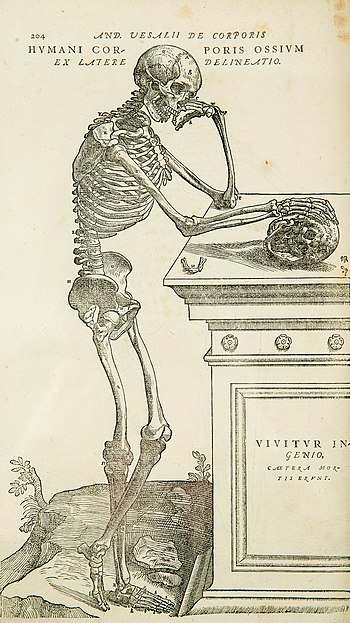
| Part of a series on |
| Biology |
|---|
Anatomy (from Ancient Greek ἀνατομή (anatomḗ) 'dissection') is the branch of morphology concerned with the study of the internal structure of organisms and their parts.[1] Anatomy is a branch of natural science that deals with the structural organization of living things. It is an old science, having its beginnings in prehistoric times.[2] Anatomy is inherently tied to developmental biology, embryology, comparative anatomy, evolutionary biology, and phylogeny,[3] as these are the processes by which anatomy is generated, both over immediate and long-term timescales. Anatomy and physiology, which study the structure and function of organisms and their parts respectively, make a natural pair of related disciplines, and are often studied together. Human anatomy is one of the essential basic sciences that are applied in medicine, and is often studied alongside physiology.[4]
Anatomy is a complex and dynamic field that is constantly evolving as discoveries are made. In recent years, there has been a significant increase in the use of advanced imaging techniques, such as MRI and CT scans, which allow for more detailed and accurate visualizations of the body's structures.
The discipline of anatomy is divided into macroscopic and microscopic parts. Macroscopic anatomy, or gross anatomy, is the examination of an animal's body parts using unaided eyesight. Gross anatomy also includes the branch of superficial anatomy. Microscopic anatomy involves the use of optical instruments in the study of the tissues of various structures, known as histology, and also in the study of cells.
The history of anatomy is characterized by a progressive understanding of the functions of the organs and structures of the human body. Methods have also improved dramatically, advancing from the examination of animals by dissection of carcasses and cadavers (corpses)[5] to 20th-century medical imaging techniques, including X-ray, ultrasound, and magnetic resonance imaging.[6]
- ^ "anatomy". Merriam-Webster.com Dictionary. Merriam-Webster.
- ^ Rotimi, Booktionary. "Anatomy". Archived from the original on 1 August 2017. Retrieved 18 June 2017.
- ^ Gray, Henry (1918). "Introduction". Anatomy of the Human Body (20th ed.). Archived from the original on 16 March 2007. Retrieved 19 March 2007 – via Bartleby.com.
- ^ Arráez-Aybar; et al. (2010). "Relevance of human anatomy in daily clinical practice". Annals of Anatomy. 192 (6): 341–48. doi:10.1016/j.aanat.2010.05.002. PMID 20591641.
- ^ Ghosh, Sanjib Kumar (2 March 2017). "Human cadaveric dissection: a historical account from ancient Greece to the modern era". Anatomy & Cell Biology. 48 (3): 153–169. doi:10.5115/acb.2015.48.3.153. PMC 4582158. PMID 26417475.
- ^ Cite error: The named reference
:1was invoked but never defined (see the help page).